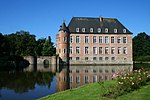Montaigle Castle
- View a machine-translated version of the Dutch article.
- Machine translation, like DeepL or Google Translate, is a useful starting point for translations, but translators must revise errors as necessary and confirm that the translation is accurate, rather than simply copy-pasting machine-translated text into the English Wikipedia.
- Do not translate text that appears unreliable or low-quality. If possible, verify the text with references provided in the foreign-language article.
- You must provide copyright attribution in the edit summary accompanying your translation by providing an interlanguage link to the source of your translation. A model attribution edit summary is
Content in this edit is translated from the existing Dutch Wikipedia article at [[:nl:Kasteel van Montaigle]]; see its history for attribution. - You may also add the template
{{Translated|nl|Kasteel van Montaigle}}to the talk page. - For more guidance, see Wikipedia:Translation.
| Montaigle Castle | |
|---|---|
| Wallonia, Belgium | |
 | |
| Type | Castle |
Montaigle Castle (French: Château de Montaigle) is a ruined medieval castle in Falaën in the municipality of Onhaye, province of Namur, Wallonia.
It was built in the 14th century, and destroyed by Henry II of France in 1554. It stands on a rocky spur overlooking the valleys of the Molignée and of the Flavion.
The site was used during the Late Roman period for a Belgo-Roman fortification.
Montaiglian, the first name of Aurignacian
Following the official web-site of Onhaye, The Belgian government commissioned in 1867 the geologist Édouard Dupont to study the caves (locally called trous, lit., "holes") located in the rocky spur of Montaigle. He named each of them after the trees growing near the cave's entrance; Trou du Sureau (Elder), Trou du Chêne (Oak), Trou de l'Erable (Maple), except the lowest one, named Trou Philippe after the name of the hermit who lived therein. Prehistoric remains were found in all of these caves; Dupont described the Cro-Magnon civilization years before the French paleontologists, but the French nomenclature was adopted, though. The "Montaiglian" layer was later renamed "Aurignacian", after the cave of Aurignac in the Pyrénées. [1] This opinion is also indirectly in a book of Marcel Otte[2] Hawthorne Harris Wilder wrote yet in 1924 Montaiglian (or Augniracian) [3]
See also
Notes
External links
- Website of the Friends of Montaigle (in French)
- Manuel d'archéologie préhistorique celtique et gallo-romaine : prehistorique celtique et gallo-romaine (1908) View of the word Montaiglien]
- Montaigle Castle Ruins, Falaën, Belgium




  | This article about a castle or château in Belgium is a stub. You can help Wikipedia by expanding it. |
- v
- t
- e












